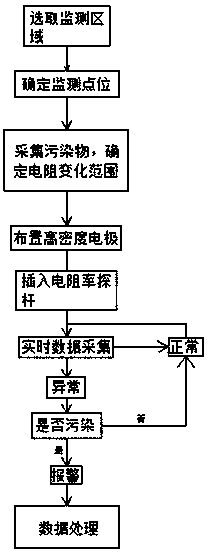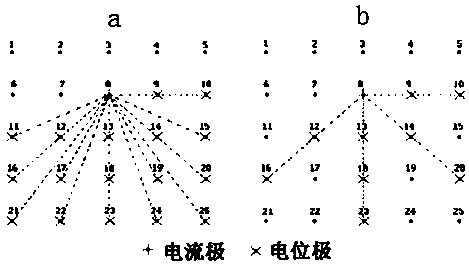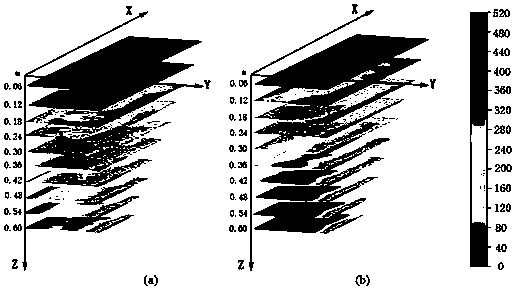Monitoring and data processing methods for underground three-dimensional migration of LNAPLs
A data processing and three-dimensional technology, applied in the direction of material resistance, etc., can solve the problems of lack of three-dimensional migration data monitoring of LNAPLs pollutants, and achieve the effects of making up for discontinuous time, convenient operation and reasonable design
- Summary
- Abstract
- Description
- Claims
- Application Information
AI Technical Summary
Problems solved by technology
Method used
Image
Examples
Embodiment 1
[0031] Such as Figure 1-4 As shown, a method for monitoring the three-dimensional migration process of LNAPLs underground includes the following steps:
[0032] 1) Determine the suspicious pollutant source area in the monitoring area, determine the monitoring point of the pollution source, and obtain the characteristic LNAPLs pollutants in the monitoring area;
[0033] 2) Select groundwater and soil samples at the monitoring points of each suspected pollution source, obtain adaptive monitoring points, and obtain the range of resistivity changes after LNAPLs pollutants migrate to each point;
[0034] 3) Lay several rows of electrodes around each monitoring point. The electrodes are distributed in a grid shape. When the electrodes are laid, they are screwed into the drilling holes of the glass bracket to fix them. The electrode insertion depth is 5cm. The laid electrodes are connected to the electrodes through multi-core cables and stainless steel clamps. The transfer switch i...
Embodiment 2
[0050] As shown in figure: 1, a kind of monitoring method of LNAPLs underground three-dimensional migration process comprises the following steps:
[0051] 1) Determine the suspicious pollutant source area in the monitoring area, determine the monitoring point of the pollution source, and obtain the characteristic LNAPLs pollutants in the monitoring area;
[0052] 2) Select groundwater and soil samples at the monitoring points of each suspected pollution source, obtain adaptive monitoring points, and obtain the range of resistivity changes after LNAPLs pollutants migrate to each point;
[0053] 3) Lay several rows of electrodes around each monitoring point. The electrodes are distributed in a grid shape. When the electrodes are laid, they are screwed into the drilling holes of the glass bracket to fix them. The electrode insertion depth is 5cm. The laid electrodes are connected to the electrodes through multi-core cables and stainless steel clamps. The transfer switch is final...
Embodiment 3
[0070] Such as Figure 4As shown, when LNAPLs pollution is detected, the water level of LNAPLs-contaminated soil is changed, and the three-dimensional resistivity image is drawn before and after the water level rises. The three-dimensional resistivity image can reflect the approximate spatial scope of LNAPLs pollution, and the main pollution is 0.15- 0.5m range, this range is the water saturated zone and capillary zone, and the main source of deep pollution is the internal injection point. The resistivity of the topsoil layer is low, and the overall resistivity increases after the water level rises, and the abnormal range of high resistivity moves up obviously, which well reflects the redistribution characteristics of LNAPLs after the water level fluctuates. .0 software grid, and then draw the apparent resistivity profiles at different depths, the depth interval is 0.05m, and the measurement depth is 0.867 times the pole spacing. The x-axis represents the direction parallel t...
PUM
| Property | Measurement | Unit |
|---|---|---|
| length | aaaaa | aaaaa |
| diameter | aaaaa | aaaaa |
| length | aaaaa | aaaaa |
Abstract
Description
Claims
Application Information
 Login to View More
Login to View More - R&D
- Intellectual Property
- Life Sciences
- Materials
- Tech Scout
- Unparalleled Data Quality
- Higher Quality Content
- 60% Fewer Hallucinations
Browse by: Latest US Patents, China's latest patents, Technical Efficacy Thesaurus, Application Domain, Technology Topic, Popular Technical Reports.
© 2025 PatSnap. All rights reserved.Legal|Privacy policy|Modern Slavery Act Transparency Statement|Sitemap|About US| Contact US: help@patsnap.com



